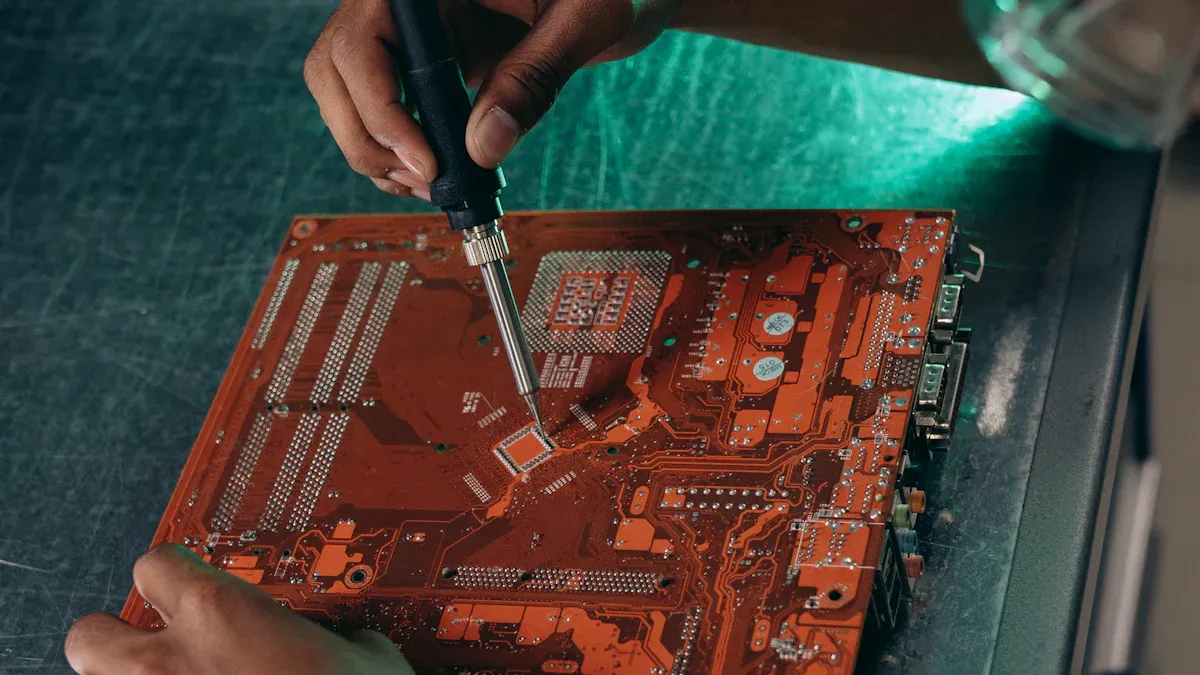How to Check and Fix a Malfunctioning Thermal Limiter
A thermal limiter is a safety part in appliances. It stops power if the appliance gets too hot. This prevents overheating and possible fires. Between 2002 and 2009, over 15,700 appliance fires were caused by defects. Fixing or replacing a broken thermal fuse keeps appliances safe. Ignoring this can cause more problems or dangers. Always unplug the appliance and let it cool before repairs. Safety should always come first!
Key Takeaways
A thermal limiter stops appliances from overheating and causing fires.
If it’s broken, there may be no heat or burnt smells.
Always unplug the appliance and let it cool before fixing it.
Use a multimeter to check if the thermal limiter works.
Get tools like screwdrivers and a new thermal fuse ready first.
Wear gloves and goggles to stay safe when working with wires.
Put the appliance back together, making sure everything fits right.
Test the appliance after fixing it to see if it works safely.
Signs of a Faulty Thermal Limiter

Symptoms of a Malfunctioning Dryer Thermal Fuse
Dryer doesn’t heat or cool.
A common sign of a blown thermal fuse is when the dryer stops heating or cooling. If clothes stay wet after drying or the drum spins without heat, the fuse might be the problem. This happens because the fuse cuts power to stop overheating.
Overheating or burnt smell while running.
A bad thermal fuse can make the dryer overheat. You might notice a burnt smell when it’s on. This smell means the dryer is too hot, which could cause damage or even a fire. Fix this issue quickly to stay safe.
Dryer turns off suddenly.
If the dryer shuts off during a cycle without warning, the thermal fuse might be broken. It may trip from too much heat, cutting power to the dryer. This safety feature prevents overheating but shows the fuse needs replacing.
Tip: Watch for these signs early. Ignoring them can cause bigger problems or ruin your dryer.
Confirming the Fault
Checking the thermal limiter with a multimeter.
To check if the thermal limiter is bad, use a multimeter. First, unplug the dryer to stay safe. Find the fuse, usually near the heater or vent. Set the multimeter to continuity mode and touch the probes to the fuse ends. A good fuse will show continuity; a bad one won’t.
Looking for visible damage or burns.
You can also check the thermal fuse by looking at it. Take it out of the dryer and see if it’s discolored, cracked, or burnt. These signs mean the fuse is blown and needs to be replaced.
Note: Be careful when handling the fuse to avoid breaking it or getting hurt.
Getting Ready to Replace a Broken Thermal Fuse
Tools and Supplies Needed
Screwdrivers, multimeter, and new thermal fuse
First, gather all the tools you need. You’ll need screwdrivers, a multimeter to test the fuse, and a new thermal fuse that fits your appliance. Picking the right fuse is very important. Check your appliance guide or ask an expert if unsure about the type.
Gloves and goggles for safety
Always put safety first. Wear gloves to protect your hands from sharp edges or shocks. Use goggles to keep dust or tiny bits out of your eyes. These items are cheap but very important for safe repairs.
Tip: Keep tools close by so you don’t have to stop often.
Doing a Safety Check
Unplugging the appliance
Before starting, unplug the appliance or turn off its power. This step keeps you safe from electrical shocks while working.
Making sure the appliance is cool
Feel the appliance to check if it’s cool. If it’s still warm, wait until it cools down completely. Working on a hot appliance can cause burns.
Choosing a bright and airy workspace
Pick a spot with good light and airflow. Bright light helps you see small parts better. Airflow keeps you from breathing in dust or fumes. A clean area also helps you avoid losing screws or parts.
Reminder: Always check for safety before fixing anything to avoid risks.
Step-by-Step Guide to Replace a Malfunctioning Thermal Fuse

Locating the Thermal Limiter
Using the appliance manual for help.
Check your appliance manual first. It gives clear steps to find the thermal fuse in your dryer or other appliances. Manuals often have pictures showing where the fuse is located. If you lost the manual, visit the maker’s website to download it.
Usual spots near heating parts or back panels.
The thermal fuse is often near the heating parts or on the back panel of dryers. Open the back panel slowly to see inside. Look for a small part connected to wires. This is likely the thermal limiter.
Tip: Snap a photo of the fuse before removing it. This helps when putting it back.
Removing the Faulty Thermal Limiter
Taking off wires carefully.
Unplug the appliance before touching the thermal fuse. Wear gloves to stay safe from shocks. Gently pull the wires off the fuse. Don’t twist them to avoid breaking anything.
Unscrewing or unclipping the limiter.
After removing the wires, take out the broken thermal fuse. Use a screwdriver or your hands, depending on how it’s attached. Be careful not to harm nearby parts. Clean the area with rubbing alcohol to remove dirt.
Note: Check the wires for damage. Replace them if needed for proper setup.
Installing the New Thermal Limiter
Attaching wires tightly to the new fuse.
Put the new thermal fuse where the old one was. Connect the wires firmly to the new fuse. Make sure they fit snugly and are straight. Loose wires can stop the fuse from working.
Securing the fuse in place.
Fix the new thermal fuse tightly using screws or clips. Ensure it’s positioned correctly and doesn’t move. This step is key for the appliance to work well.
Reminder: Test the connections with a multimeter after installing the new fuse. This confirms it’s ready to use.
Reassembling the Appliance
Making sure all parts are put back correctly
After putting in the new thermal fuse, reassemble the appliance carefully. Place each part back where it belongs. Use the photo you took or the manual to guide you. Line up screws, panels, and wires exactly as they were before. Even small mistakes can make the appliance work poorly.
If needed, check for lubrication on moving parts. For example, in washers, adding grease can help parts move better and last longer. Use good-quality grease like Instrument Grease 794A to avoid wear and tear. Proper assembly improves how the appliance works and prevents expensive repairs later.
Tip: Attach one part at a time to avoid missing anything.
Checking for loose wires or screws
Before closing the appliance, look closely at all connections. Loose wires or screws can cause problems like overheating or not working. Gently pull each wire to make sure it’s tight. Tighten any loose screws with the right tool.
Pay extra attention to the wires on the new thermal fuse. These must be tight for the fuse to work properly. A loose wire here could make the appliance overheat or stop suddenly.
When done, inspect the appliance one last time. Look for misplaced parts, loose wires, or gaps in panels. A properly assembled appliance works better and lasts longer.
Reminder: Checking your work now can prevent problems later.
Testing the Appliance After Replacement
Powering On the Appliance
Plugging in and turning on the appliance.
Once the appliance is put back together, plug it in. Turn it on and watch how it starts. Check if it powers up smoothly without stopping or delays. This step shows if the thermal limiter was installed correctly and the appliance is getting power.
Observing for normal operation.
After turning it on, watch how the appliance works. Make sure it runs as it should. For example, if it’s a dryer, check if the drum spins and buttons work. Look for strange things like flickering lights or uneven performance. These might mean wires are loose or something else is wrong.
Tip: Stay close to the appliance. Turn it off quickly if needed.
Verifying the Fix
Checking for proper heating or cooling functionality.
Test the appliance to see if it works right. For a dryer, check if it heats up. Put damp clothes inside and run a short cycle. See if the clothes dry well, showing the thermal limiter is working. For cooling appliances, make sure they reach the right temperature.
Ensuring no unusual noises or smells.
Listen for odd sounds like buzzing or rattling while it runs. These noises might mean parts are loose or not put together right. Also, check for strange smells like burning or overheating. A good appliance should be quiet and smell normal. If anything seems wrong, turn it off and check the parts.
Reminder: Follow these steps to make sure the appliance is safe to use.
Suggested Testing Protocols
Performing a safety check: Before testing, make sure all wires are tight and covered. Use a multimeter to test the new thermal limiter for continuity and resistance.
Running a test cycle: After checking safety, turn on the appliance and watch it work. Check temperature changes and listen for odd sounds during the cycle.
By following these steps, you can safely test the dryer or other appliances after fixing the thermal limiter. This helps confirm the repair worked and the appliance is ready to use.
Troubleshooting Problems After Replacing the Thermal Limiter
Appliance Still Not Working
Checking how the thermal limiter was installed
If your appliance doesn’t work after replacing the thermal limiter, check your installation. Make sure all wires are tightly connected to the new limiter. Loose wires can stop the appliance from working. Use a multimeter to test the limiter again for continuity. This will confirm if the new part is working correctly.
Look at nearby parts for damage. Sometimes, the thermal limiter fails because of other broken parts, like a bad heater or motor. Check for wear, burns, or discoloration. Replace any damaged parts you find right away.
Testing other parts for problems
If the thermal limiter isn’t the issue, other parts might be causing trouble. Run a diagnostic check to find the problem. Use the table below to help with your inspection:
Diagnostic Check | What to Look For |
|---|---|
Loose Connections | Make sure all wires, especially to the heater, are tight. |
Wiring Inspection | Check wires, door switches, and motor connections for damage or wear. |
Thermal Fuse Role | Learn how the fuse works to find overheating causes. |
If the thermal fuse blew because of too much current, think about adding a second fuse. Use 14-gauge stranded wire and put the new fuse in a PVC tube for safety. This setup lowers the current through each fuse, making it more reliable.
Appliance Overheating or Acting Up
Confirming the right thermal limiter was used
Overheating or problems can happen if the wrong thermal limiter was installed. Check the part number and details of the replacement limiter. Look at your appliance manual or ask an expert to make sure it’s the right one. A budget-friendly option like NTE Electronics Disc Thermostats can work well.
Checking for wiring problems or blockages
Blocked air vents or ducts can cause overheating. Look at the appliance’s vents for clogs. Clean out lint, dust, or debris that might block airflow. For appliances like blenders, don’t overload them, as this can overwork the motor and trip the thermal fuse.
Blocked vents can trap heat, harming the thermal limiter and other parts. Check wires for damage or fraying. Replace bad wires to avoid more problems. Cleaning air ducts and vents regularly can stop overheating and help your appliance last longer.
Tip: Keep your appliance clean and don’t overload it. This helps prevent overheating and keeps it running smoothly.
Finding and fixing a bad thermal limiter keeps your appliance safe. Fixing it early avoids dangers and expensive repairs later. Always stay safe by unplugging the appliance and using proper tools. These steps help protect your appliance and make you feel secure.
If you're unsure about any step, ask an expert for help. A professional can fix it right and keep your appliance working well.
FAQ
1. What does a thermal limiter do?
A thermal limiter stops overheating by cutting power when it gets too hot. It keeps your appliance safe and lowers fire risks. Without it, the appliance could overheat and break.
2. How can you tell if a thermal fuse is bad?
Signs include no heat or cooling, sudden stops, or burnt smells. Use a multimeter to check for continuity. A bad fuse won’t show continuity and may look burnt or cracked.
3. Can you replace a thermal limiter on your own?
Yes, you can replace it with simple tools like screwdrivers and a multimeter. Always unplug the appliance and wear gloves for safety. If unsure, ask a professional for help.
4. What tools are needed to replace a thermal fuse?
You’ll need screwdrivers, a multimeter, and a new fuse. Safety items like gloves and goggles are also important. Check your appliance manual for exact tools.
5. Why does a thermal fuse fail?
A thermal fuse fails due to overheating from blocked vents, bad wiring, or overloading. Cleaning vents often helps prevent overheating and makes the fuse last longer.
6. How do you test a thermal limiter using a multimeter?
Set the multimeter to continuity mode. Touch its probes to the fuse ends. If it beeps or shows continuity, the fuse works. If not, it’s broken and needs replacing.
7. What happens if you use the wrong thermal fuse?
Using the wrong fuse can cause overheating or problems. Always check the part number and details in your manual. A wrong fuse might harm your appliance.
8. How often should you check the thermal limiter?
Check the thermal limiter during regular maintenance or if the appliance acts up. Routine checks keep it safe and avoid expensive repairs.
Tip: Keep your appliance manual nearby for help with checks and fixes.
See Also
Safe Steps to Replace Your Blower Motor Resistor
Testing HVAC Capacitors Using a Multimeter: A Quick Guide
Identifying Issues with Your Canister Purge Valve Easily
